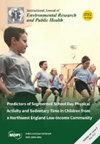体育锻炼对 2020 年美国 18 岁或以上成年人记忆力衰退和注意力不集中的影响
3区 综合性期刊
Q1 Medicine
International Journal of Environmental Research and Public Health
Pub Date : 2024-09-09
DOI:10.3390/ijerph21091193
引用次数: 0
摘要
这项横断面研究使用了美国 2020 年国民健康访谈调查数据库中的二手数据。本研究的目的是概述体育锻炼对认知和心智能力的影响。我们之所以选择进行这项研究,是因为认知障碍和疾病造成的经济和精神负担呈指数级增长。主要结果是个人是否出现记忆力减退和注意力难以集中等痴呆症症状。主要暴露因素是是否遵守体育锻炼指南(无、仅锻炼力量、仅锻炼有氧运动、两者兼有)。混杂因素包括年龄、性别、地区、心脏病状况、吸烟状况、饮酒状况和抑郁状况。样本由 30,119 名 18 岁或以上的美国成年人组成。其中 46% 为男性,54% 为女性。按年龄划分,96%的参与者年龄在 18-84 岁之间,约 4% 的参与者年龄在 85 岁及以上。逻辑回归分析用于计算几率比(OR)和 95% 的置信区间(CI)。从统计学角度看,难以遵守体育锻炼指南与认知障碍之间存在明显联系。与同时符合两个标准的人相比,只符合有氧运动标准的人出现认知障碍的几率增加了 52%(OR 1.52;95% CI:1.34-1.74)。与同时符合这两个标准的人相比,符合力量标准的人出现认知障碍的几率要高出 1.7(OR 1.70;95% CI:1.42-2.02)。既不符合这两项标准的患者出现认知障碍的几率(OR 2.64;95% CI:2.36-2.96)几乎是同时符合这两项标准的患者的三倍。研究人员和医疗保健提供者应该合作,鼓励人们遵守这些指南,并消除妨碍人们参加体育锻炼的障碍,如身体限制和获得安全娱乐空间的障碍。未来的研究应解决体育锻炼方面的健康差异问题。本文章由计算机程序翻译,如有差异,请以英文原文为准。
The Impact of Physical Activity on Memory Loss and Concentration in Adults Aged 18 or Older in the U.S. in 2020
This cross-sectional study used secondary data from the USA 2020 National Health Interview Survey database. The goal of this study is to outline the impact physical activity has on cognition and mental ability. The reason we chose to pursue this research was a result of the exponentially growing weight of economic and emotional burden caused by cognitive impairments and diseases. The main outcome was whether individuals experienced dementia symptoms such as memory loss and difficulty concentrating. The main exposure was following physical activity guidelines (none, strength only, aerobic only, both). The confounders included age, sex, region, heart disease status, smoking status, drinking status, and depression status. The sample is composed of 30,119 USA adults aged 18 or older. Of those participants, 46% were male and 54% were female. By age, 96% were 18–84 years old, and approximately 4% were 85 and older. Logistic regression analysis was used to calculate odds ratios (ORs) and 95% confidence intervals (CIs). There was a statistically significant association between difficulty following physical activity guidelines and cognitive difficulties. Those who met aerobic only increased the odds of cognitive difficulty by 52% (OR 1.52; 95% CI: 1.34–1.74) compared with those who met both criteria. Those who met the strength criteria had 1.7 greater odds of cognitive difficulties (OR 1.70; 95% CI: 1.42–2.02) than those who met both criteria. Those who met neither of these guidelines had almost threefold greater odds of having cognitive difficulties (OR 2.64; 95% CI: 2.36–2.96) than those who met both guidelines. Researchers and healthcare providers should collaborate to encourage meeting these guidelines and addressing barriers preventing people from being physically active, such as physical limitations and access to safe recreational spaces. Future studies should address the health disparities regarding physical activity.
求助全文
通过发布文献求助,成功后即可免费获取论文全文。
去求助
来源期刊

International Journal of Environmental Research and Public Health
Medicine-Public Health, Environmental and Occupational Health
CiteScore
7.30
自引率
0.00%
发文量
14422
审稿时长
1 months
期刊介绍:
International Journal of Environmental Research and Public Health (IJERPH) (ISSN 1660-4601) is a peer-reviewed scientific journal that publishes original articles, critical reviews, research notes, and short communications in the interdisciplinary area of environmental health sciences and public health. It links several scientific disciplines including biology, biochemistry, biotechnology, cellular and molecular biology, chemistry, computer science, ecology, engineering, epidemiology, genetics, immunology, microbiology, oncology, pathology, pharmacology, and toxicology, in an integrated fashion, to address critical issues related to environmental quality and public health. Therefore, IJERPH focuses on the publication of scientific and technical information on the impacts of natural phenomena and anthropogenic factors on the quality of our environment, the interrelationships between environmental health and the quality of life, as well as the socio-cultural, political, economic, and legal considerations related to environmental stewardship and public health.
The 2018 IJERPH Outstanding Reviewer Award has been launched! This award acknowledge those who have generously dedicated their time to review manuscripts submitted to IJERPH. See full details at http://www.mdpi.com/journal/ijerph/awards.
 求助内容:
求助内容: 应助结果提醒方式:
应助结果提醒方式:


